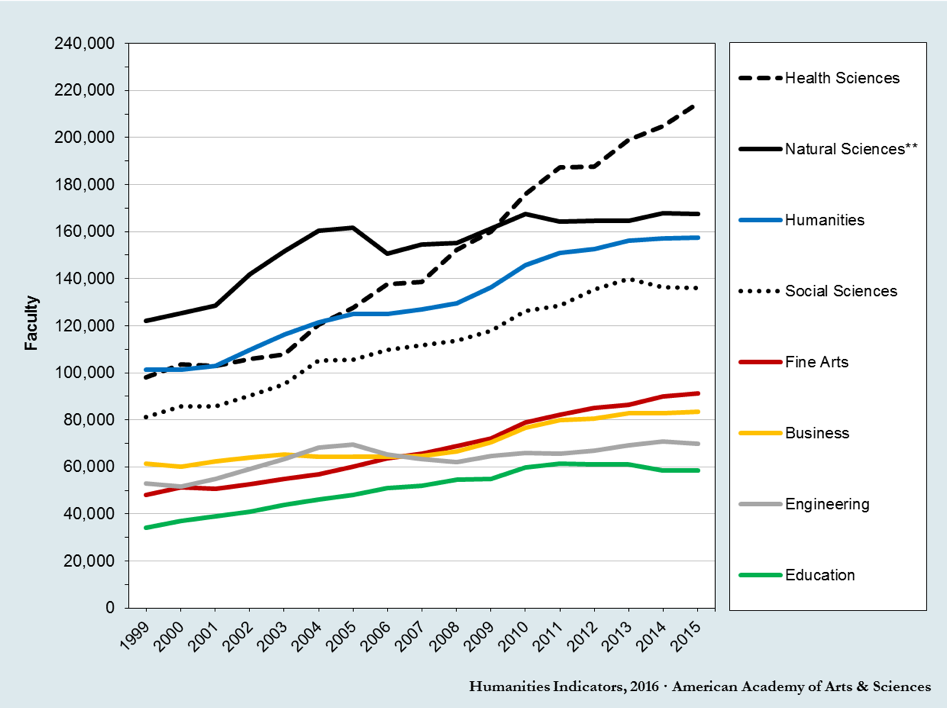The arrival of annual reports on the job market in various humanities fields this year left many graduate students depressed about their prospects and professors worried about the futures of their disciplines. English and foreign language openings were , respectively.
On Sunday, the Çï¿ûÊÓƵ released several new that show that these declines, part of a continuing pattern, are far more dramatic when viewed over a longer time frame. The academy also released new data showing that the proportion of all faculty members who are in the humanities -- crucial not only to their own fields but to general education at many colleges and universities -- has been flat amid substantial gains for the health professions.
Data on New Jobs
For all humanities disciplines, listings for positions are at least 31 percent below the levels reported in the 2007-08 academic year, the last year before the economic downturn hit in 2008. Many of these fields were relatively stable or even increasing in the years leading up to 2008, so the most recent data from the academy show significant long-term losses.
Job Listings in Humanities Disciplines
The data come from various disciplinary associations' studies of the job market. Those studies don't include all jobs in their fields, but are generally indicative of trends.
Data on Job Totals
The academy is also releasing new data on changes in the total number of humanities faculty jobs in American higher education, and the share of all faculty jobs they represent. The analysis comes from statistics obtained from the U.S. Bureau of Labor Statistics. Some highlights:
- In 2015, 157,540 humanities faculty members were employed by American two- and four-year colleges and universities in the disciplines of area/ethnic/cultural studies, history, languages and literatures, philosophy, and religion (the only humanities disciplines tracked by the bureau). The totals include full-time and part-time faculty members.
- The total number of humanities faculty members increased by 5 percent from 1999 to 2013, but slowed to less than 1 percent the next two years. From 1999 to 2013, total postsecondary enrollments in the humanities increased by 41 percent.
- The disciplinary area seeing the most growth in recent years has been heath sciences, in which the number of faculty members increased 103 percent from 1999 to 2013 and then 8 percent in the last two years.
- From 2004, the share of all faculty members who were in the humanities was relatively stable, fluctuating between 11 and 12 percent. But the share of faculty working in the health sciences rose from 11 percent to more than 16 percent over the same period. The shares of faculty members in the natural sciences and engineering declined slightly.
Number of Postsecondary Faculty Members, by Field

The academy commissioned an essay on the trends by Leonard Cassuto, a professor of English and American studies at Fordham University, and author of The Graduate School Mess: What Caused It and How We Can Fix It (Harvard University Press). appears today on Inside Higher Ed.
Shift in History Doctoral Programs
Also on Sunday, the History News Network published the by Robert B. Townsend, director of the Washington office of the Çï¿ûÊÓƵ. He found some signs of change in doctoral programs related to shifts in the job market. For example, a plurality of programs said that they aspired to balance preparation for teaching and research, compared to past survey results indicating a clear research emphasis. Many have suggested that those trained for teaching careers may fare better in finding jobs.
Also, greater shares of departments than was the case in the survey 15 years ago indicated that their new Ph.D.s were trained for a variety of careers, including community college teaching and jobs in government and business.